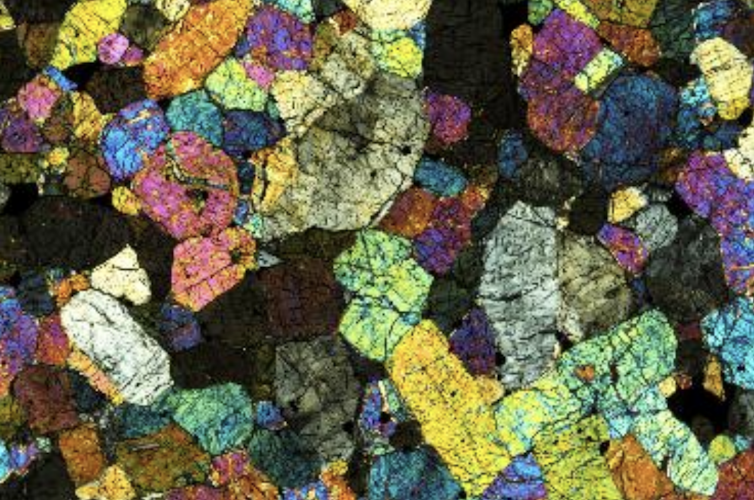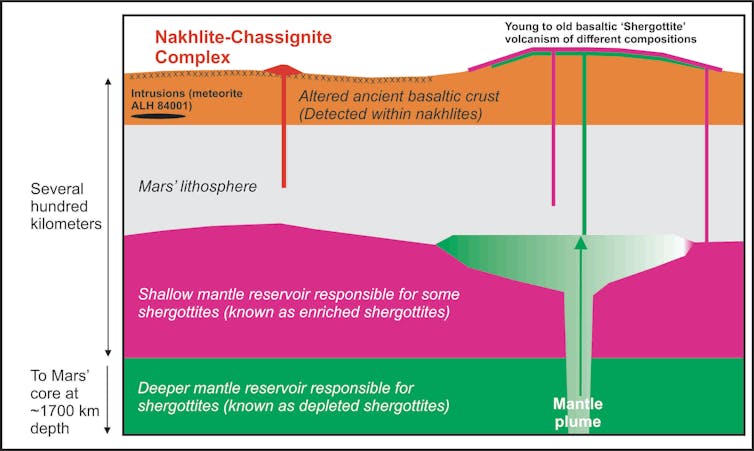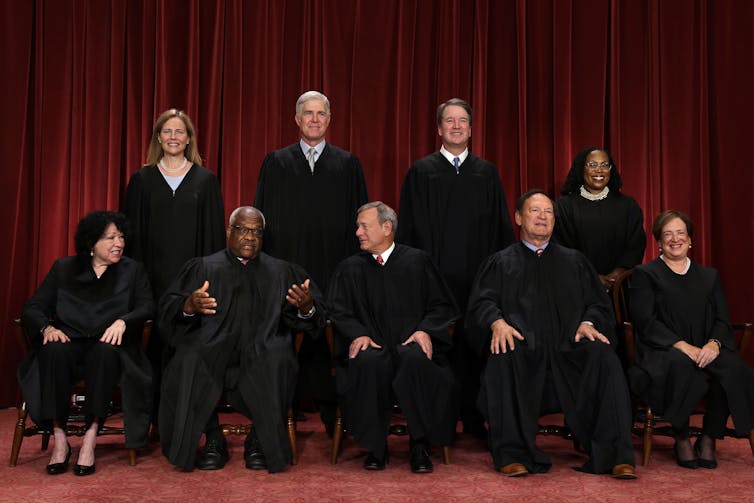
Of the more than 74,000 known meteorites – rocks that fall to Earth from asteroids or planets colliding together – only 385 or so stones came from the planet Mars.
It’s not that hard for scientists to work out that these meteorites come from Mars. Various landers and rovers have been exploring Mars’ surface for decades. Some of the early missions – the Viking landers – had the equipment to measure the composition of the planet’s atmosphere. Scientists have shown that you can see this unique Martian atmospheric composition reflected in some of these meteorites.
Mars also has unique oxygen. Everything on Earth, including humans and the air we breathe, is made up of a specific composition of the three isotopes of the element oxygen: oxygen-16, oxygen-17 and oxygen-18. But Mars has an entirely different composition – it’s like a geochemical fingerprint for being Martian.
The Martian meteorites found on Earth give geologists like me hints about the makeup of the red planet and its history of volcanic activity. They allow us to study Mars without sending a spacecraft 140 million miles away.
A planet of paradoxes
These Martian meteorites formed from once red-hot magma within Mars. Once these volcanic rocks cooled and crystallized, radioactive elements within them started to decay, acting as a radiometric clock that enables scientists to tell when they formed.
From these radiometric ages, we know that some Martian meteorites are as little as 175 million years old, which is – geologically speaking – quite young. Conversely, some of the Martian meteorites are older, and formed close to the time Mars itself formed.
These Martian meteorites tell a story of a planet that has been volcanically active throughout its entire history. In fact, there’s potential for Martian volcanoes to erupt even today, though scientists have never seen such an eruption.
The rocks themselves also preserve chemical information that indicates some of the major events on Mars happened early in its history. Mars formed quite rapidly, 4.5 billion years ago, from gas and dust that made up the early solar system. Then, very soon after formation, its interior separated out into a metallic core and a solid rocky mantle and crust.
Since then, very little seems to have disturbed Mars’ interior – unlike Earth, where plate tectonics has acted to stir and homogenize its deep interior. To use a food analogy, the Earth’s interior is like a smoothie and Mars’ is like a chunky fruit salad.

Martian volcano remnants
Understanding how Mars underwent such an early and violent adolescence, yet still may remain volcanically active today, is an area of great interest to me. I would like to know what the inside of Mars looks like, and how its interior makeup might explain features, like volcanoes, on the red planet’s surface.
When geologists set out to answer questions about volcanism on Earth, we typically examine lava samples that erupted at different places or times from the same volcano. These samples allow us to disentangle local processes specific to each volcano from planetary processes that take place at a larger scale.
It turns out we can do the same thing for Mars. The rather exotically named nakhlite and chassignite meteorites are a group of rocks from Mars that erupted from the same volcanic system some 1.3 billion years ago.
Nakhlites are basaltic rocks, similar to lavas you would find in Iceland or Hawaii, with beautiful large crystals of a mineral known as clinopyroxene. Chassignites are rocks made almost entirely of the green mineral olivine – you might know the gem-quality variety of this mineral, peridot.
Along with the much more common shergottites, which are also basaltic rocks, and a few other more exotic Martian meteorite types, these categories of meteorite constitute all the rocks researchers possess from the red planet.
When studied together, nakhlites and chassignites tell researchers several things about Mars. First, as the molten rock that formed them oozed to the surface and eventually cooled and crystallized, some surrounding older rocks melted into them.
That older rock doesn’t exist in our meteorite collection, so my team had to tease out its composition from the chemical information we obtained from nakhlites. From this information, we learned that the older rock was basaltic in composition and chemically distinct from other Martian meteorites. We found that it had been chemically weathered by exposure to water and brine.
This older rock is quite different from the Martian crust samples in our meteorite collection today. In fact, it is much more like what we would expect the Martian crust to look like, based on data gathered by rover missions and satellites orbiting Mars.
We know that the magmas that made nakhlites and chassignites come from a distinct portion of Mars’ mantle. The mantle is the rocky portion between Mars’ crust and metallic core. These nakhlites and chassignites come from the solid rigid shell at the top of Mars’ mantle, known as the mantle lithosphere, and this source makes them distinct from the more common shergottites.
Shergottites come from at least two sources within Mars. They may come from parts of the mantle just beneath the lithosphere, or even the deep mantle, which is closer to the planet’s metallic core.
Understanding how volcanoes on Mars work can inform future research questions to be addressed by missions to the planet. It can also help scientists understand whether the planet has ever been habitable for life, or if it could be in the future.
Hints at habitability
Earth’s active geological processes and volcanoes are part of what makes our planet habitable. The gases emanating from volcanoes are a major part of our atmosphere. So if Mars has similar geological processes, that could be good news for the potential habitability of the red planet.
Mars is much smaller than Earth, however, and studies suggest that it’s been losing the chemical elements essential for a sustainable atmosphere since it formed. It likely won’t look anything like Earth in the future.
Our next steps for understanding Mars lie in learning how the basaltic shergottite meteorites formed. These are a diverse and richly complex set of rocks, ranging in age from 175 million years to 2.4 billion years or so.
Studying these meteorites in greater detail will help to prepare the next generation of scientists to analyze rocks collected using the Perseverance Rover for the forthcoming NASA Mars Sample Return mission.![]()
James Day, Professor of Geosciences, University of California, San Diego
This article is republished from The Conversation under a Creative Commons license.





 While traditional methods of soothing like bassinets and swings are often effective, they typically require parents to always be close by to keep baby calm. Bassinets and swings with innovative, soothing technology can help provide the safest place outside your arms to ensure baby is comforted and secure, allowing busy parents to have peace of mind while managing everyday tasks.
While traditional methods of soothing like bassinets and swings are often effective, they typically require parents to always be close by to keep baby calm. Bassinets and swings with innovative, soothing technology can help provide the safest place outside your arms to ensure baby is comforted and secure, allowing busy parents to have peace of mind while managing everyday tasks. Rock Your Baby to Comfort
Rock Your Baby to Comfort



